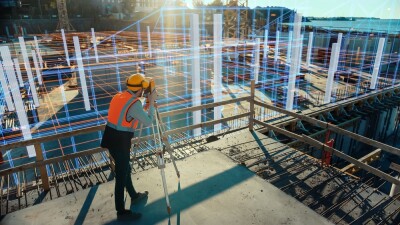Contributed by Usman Shuja, CEO - Bluebeam
Construction may be finally having its technological breakthrough.
Long considered a technology laggard, unwilling to move from paper plans and analog processes and workflows, the construction industry these past few years has seen enthusiasm and excitement for new technology solutions go into overdrive.
The $12 trillion, slow-to-digitize global construction industry between 2020-2022 experienced an explosive $50 billion investment in sector-specific technology, according to management consulting firm McKinsey & Co., citing the most recently available data. That’s 85 percent higher than in the previous three years.
The needed rise in remote work during the pandemic required most office-based construction workers to adopt new tools for digital collaboration, accelerating the move from paper-based document plan management that had been long in the making.

Today, that enthusiasm has carried over beyond the simple transition from paper to digital or use of cloud-based collaboration tools. The various sects of Artificial Intelligence (AI), led by generative AI, and 3D models by way of building information modeling (BIM), among other technology innovations, are attracting all sorts of excitement in the construction industry and beyond. Investments in AI in all industries, construction included, have seemingly reached a fever pitch these past two years.
As someone who has spent much of my professional career working on and leading teams to innovate and grow the use and application of AI, there’s arguably no one more excited than I am that this technology is at such a critical point in its lifecycle. And in nearly a year in my role as CEO of Bluebeam, a company that is pushing hard to integrate AI and other similar technology into our suite of digital PDF markup and collaboration tools for construction, it’s exhilarating to experience this excitement alongside my technology-minded peers.
Nevertheless, as I continue to have conversations with customers and observe the idiosyncrasies of the millions of disparate people that comprise the construction industry workforce, I worry that there’s a growing disconnect between how these technologies are being built and marketed, and how workers in the field—those pouring concrete and setting steel beams—communicate, operate and think.
Put simply, these workers may not be super psyched about AI. They may not be easily impressed or moved by advances in predictive analytics’ use on jobsites, the potential for bricklaying robots or fancy 3D models.
Instead, they’re focused on the next concrete pour, drywall hang or electrical, plumbing or structural challenge. They want the information they need, when they need it, in the clearest way possible, in the fastest amount of time. Then they’re on to the next job, and the job after that.
Tools that fail on any of these fronts will be tossed aside for ones that get the job done on time and on budget—and if that happens to be paper or another analog option, so be it.
The popular response to these worker attitudes in construction would be to attack their lack of technology proficiency or, worse, these workers’ age. Technology isn’t the problem, this thinking goes, it’s workers’ inability or desire to use it.
These frustrations are understandable, but my observations of field workers or other tradespeople in construction paint a more complicated picture. It’s not always that they aren’t capable of understanding technology or are unwilling to change. It’s that, in many respects, these emerging tools haven’t sufficiently considered field workers’ needs and perspectives when they are designed and built.

So, what can we, the construction industry technology provider community, learn from this?
First, for any technology tool to be useful on jobsites, they must conform to the context of a jobsite. Tools that are too complex to navigate or fail to consider proper safety considerations will struggle to gain traction. Safety and simplicity are of utmost importance in any user environment, but especially so in construction, where workers are putting their bodies and lives on the line.
Second, innovating in construction technology isn’t a top-down endeavor. For the industry to truly create technological breakthroughs that increase efficiency and add value in previously unfathomable ways, technology providers must co-create and collaborate with construction’s most common denominator: the workers in the field. Including field worker perspectives from the earliest product design stages is essential.
Third, leaders in the construction technology space need to spend time on jobsites. Secondhand information won’t cut it. To understand construction field workers’ perspectives and challenges in a way that translates to building technology that addresses them, leaders need to see, hear and touch the jobsite.
Finally, after co-creating with field workers and experiencing jobsites firsthand, construction technology leaders need to identify and reconcile with the fact that, while it is inherent to want to devise a technology solution to every problem—or, in the age of AI, replace every human task with a computer generative one—not every problem or challenge on the jobsite is best served by a technology-enabled solution.
Understanding when technology is a net benefit alongside the construction field worker, and in collaboration with their in-office industry counterparts, is when the evolving partnership between technology and people in the built world will truly reach its maximum potential.
Creating technology with field workers top of mind is the first step in that journey.
 Usman Shuja is the CEO of Bluebeam and the Chief Division Officer of the Construct and Build Division for the Nemetschek Group. In this dual role he is responsible for growth and innovation on a global scale with an emphasis on technology and sustainability. Previously, Shuja led Honeywell’s Connected Building, one of Honeywell’s largest software businesses and was a founding member of the AI unicorn, SparkCognition. He currently serves as an advisor to DARPA regarding the commercialization of advanced applications of AI and holds an MPA from the Kennedy School of Government at Harvard University where he focused on innovation policy and ethical application of AI. Shuja also holds an MBA from the Kellogg School of Management at Northwestern University and a BS in Computer Science from the University of Texas at Austin.
Usman Shuja is the CEO of Bluebeam and the Chief Division Officer of the Construct and Build Division for the Nemetschek Group. In this dual role he is responsible for growth and innovation on a global scale with an emphasis on technology and sustainability. Previously, Shuja led Honeywell’s Connected Building, one of Honeywell’s largest software businesses and was a founding member of the AI unicorn, SparkCognition. He currently serves as an advisor to DARPA regarding the commercialization of advanced applications of AI and holds an MPA from the Kennedy School of Government at Harvard University where he focused on innovation policy and ethical application of AI. Shuja also holds an MBA from the Kellogg School of Management at Northwestern University and a BS in Computer Science from the University of Texas at Austin.





.jpg.small.400x400.jpg)

